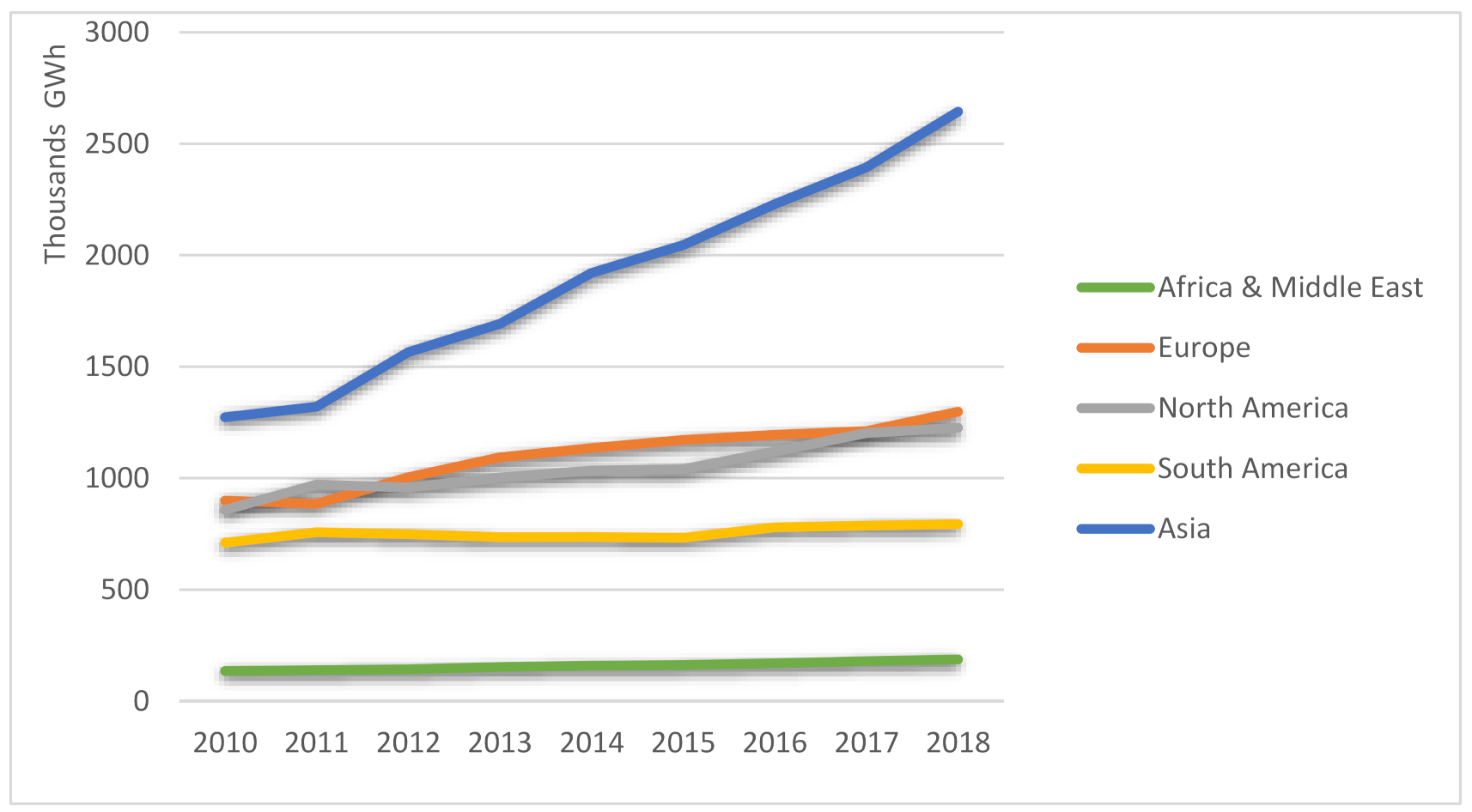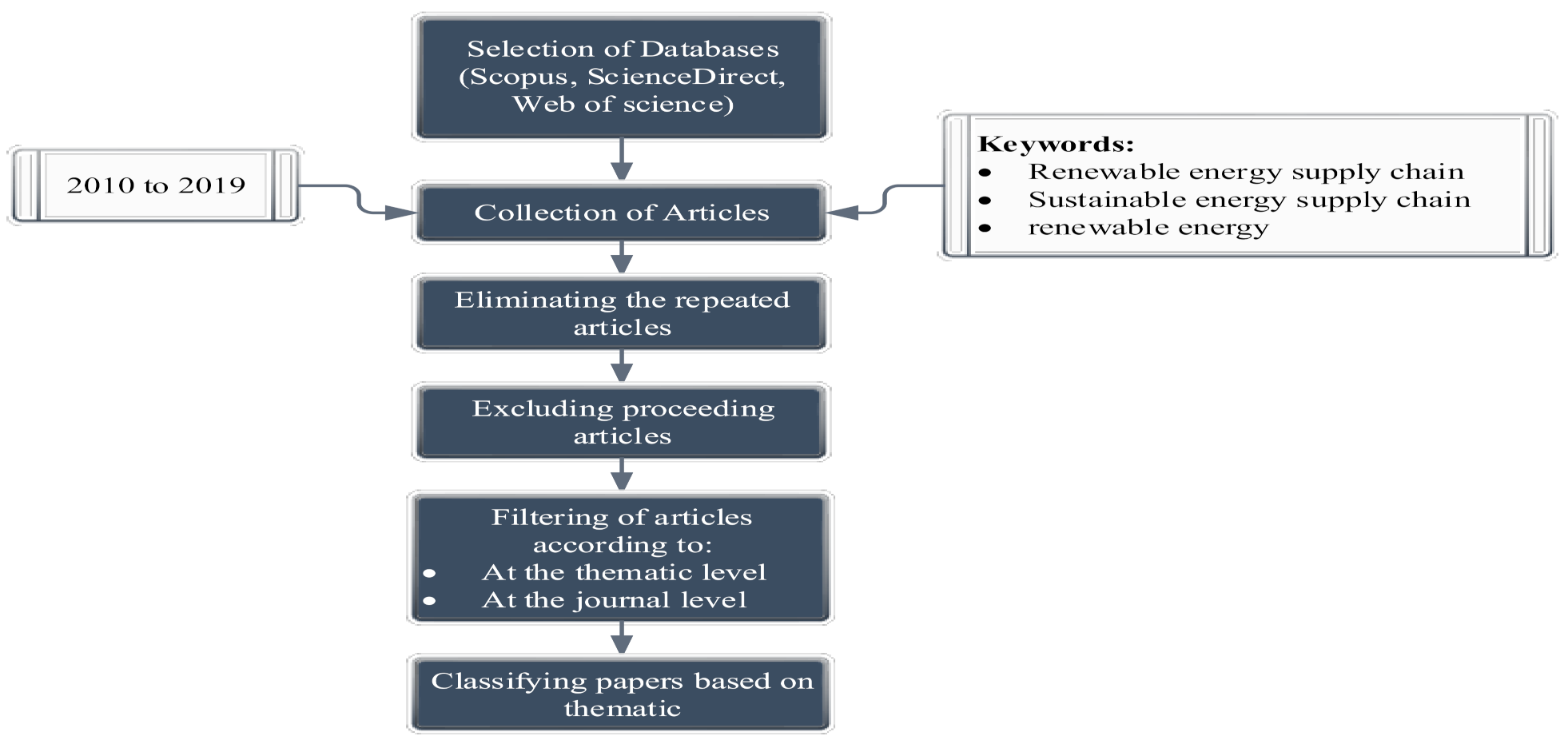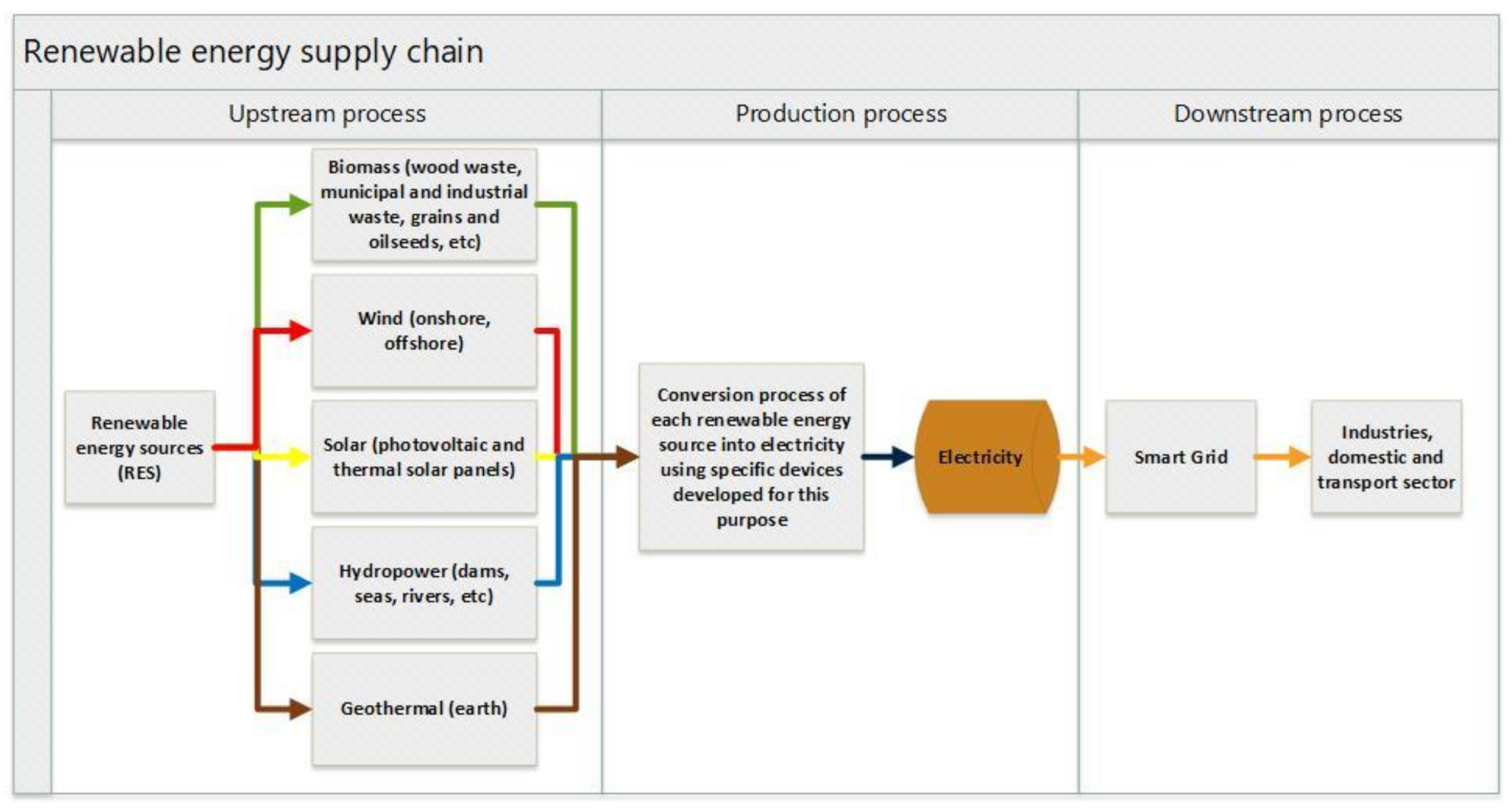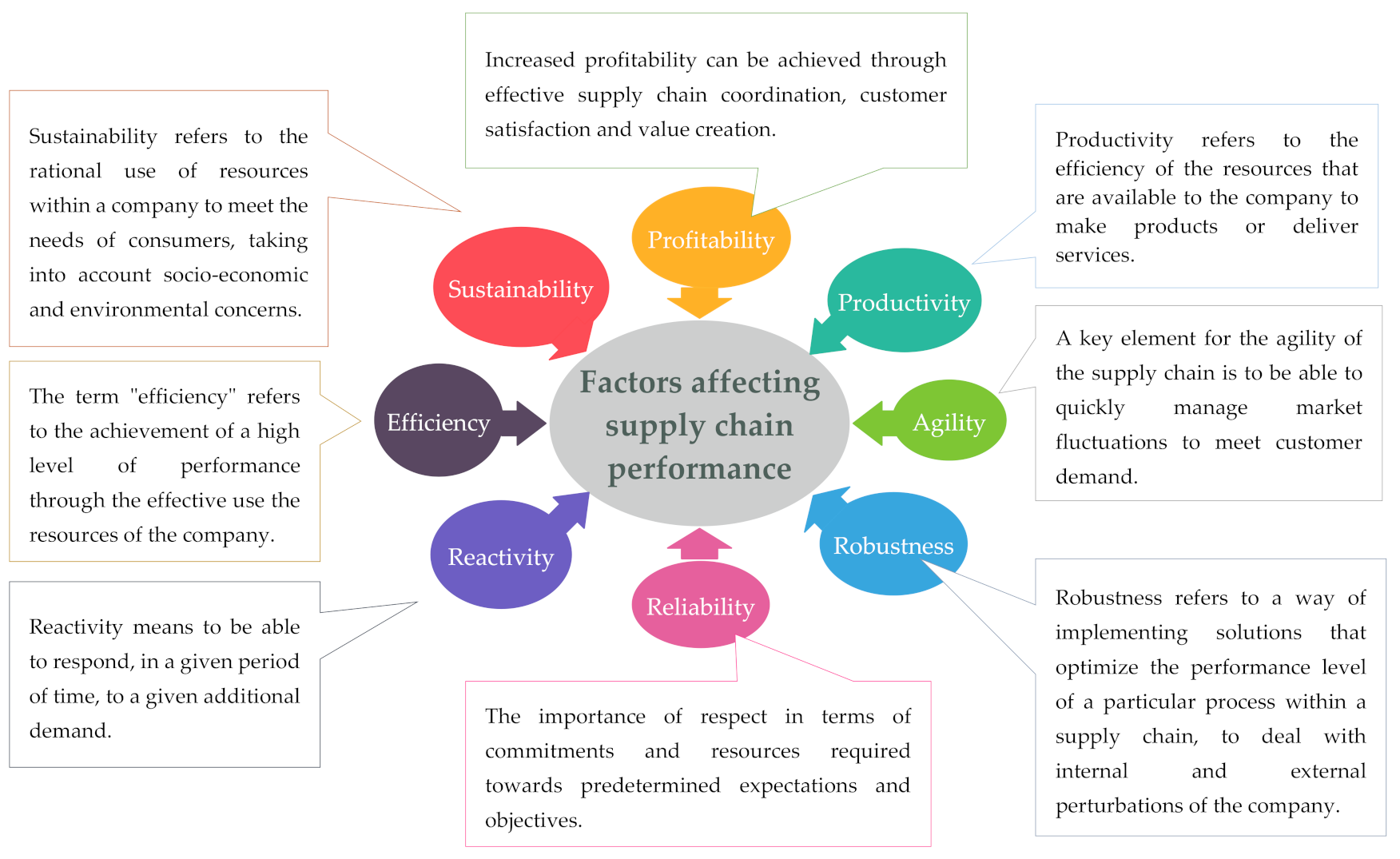Renewable Power Generation: A Supply Chain Perspective
Abstract
:1. Introduction
1.1. Background
1.2. Paper Scope
2. Renewable Energy Supply Chain
2.1. Definition of the Concept “Renewable Energy Supply Chain”
2.2. Supply Chain by Renewable Energy Sources
- (a)
- The energy supply chain for biomass resources:
- Strategic level: It is a long-term decision that includes the establishment of appropriate biomass supply systems, the installation of conversion devices, and the setting up of industrial sites and depots.
- Tactical level: It is a medium-term decision to establish the overall planning in terms of the logistics operation (storage, transport, collection), and to identify the appropriate means of transportation.
- Operational level: It is a short-term decision that involves detailed planning of all operations performed in daily operations within the supply chain as a whole.
- (b)
- The energy supply chain for wind resources:
- (c)
- The energy supply chain for solar resources:
- (d)
- The energy supply chain for water resources:
- (e)
- The energy supply chain for geothermal resources:
3. Barriers, Measures and Performance Assessment for the Development of the Renewable Energy Supply Chain
3.1. Various Barriers to the Development of the Renewable Energy Supply Chain
- (a)
- Political and regulatory dimension
- (b)
- Technical dimension
- (c)
- Economical and financial dimension:
- (d)
- Managerial dimension
3.2. Key Measures for the Development of the Renewable Energy Supply Chain
- (a)
- General key measures for the development of the renewable energy supply chain:
- (1)
- Liberalization of the energy sectorThe liberalization of the energy sector is one of the main measures, which requires the implementation of various policy initiatives to organize a transparent and competitive market [71]. All these initiatives represent significant progress towards the liberalization of the sector, but their successful change will require new regulatory mechanisms (e.g., external regulatory institutions to ensure the effective execution of these initiatives). In general, the objective of liberalizing the energy sector is to increase efficiency and competitiveness in the market [29,72].
- (2)
- Elimination of subsidies for conventional energyIt is worth noting that fossil energy technologies indirectly receive subsidies because of the international agreements related to the energy sector. Therefore, the government should impose new policies and regulations limiting the use of fossil energy technologies and trigger a transition towards renewable energy technologies, which offer considerable socio-economic and environmental benefits. For this reason, financial support for the development of the renewable energy sector will help to maintain a cost-effective energy pricing policy for consumers [73,74].
- (3)
- Public–private partnershipThe participation of the private and public sectors to finance projects related to the renewable energy sector is increasingly important in terms of enhancing efficiency in project implementation. Therefore, an intensive support mechanism for public–private partnerships should be formed to achieve the sustainable development of this sector. This can make a significant contribution to the smooth running of projects [29].
- (4)
- Access to financial incentivesEstablishing financial incentive mechanisms to stimulate renewable energy utilization has helped to meet the logistics costs for sector expansion and to ensure competitiveness in the market. This initiative also offers various types of financial incentive mechanisms, such as low-interest credits, reductions based on electricity production [75,76].
- (5)
- Measures to facilitate administrative proceduresGovernments adopted important measures to facilitate administrative procedures, such as guidelines on financing procedures for renewable energy projects and the assessment of the resources needed for the implementation of such projects [77].
- (b)
- Specific key measures for renewable energy supply chain development:The following specific key measures can be classified into three categories in line with renewable energy sources:
- (1)
- Recommendations for the development of the supply chain for biomassSustainable production of adequate quantities of biomass is a major issue in addition to storage constraints for biomass energy. Basically, three methods can be retained: storage on the ground with low storage costs, intermediate storage between farmers and stations which require higher delivery costs, and finally storage close to the station which optimizes delivery costs [46]. Therefore, optimized storage solutions for biomass sources make an important contribution in terms of cost reduction, the flexibility of the supply system, and sustainability of the supply chain [78].
- (2)
- Recommendations for the development of the supply chain for windSome of the main best practices in the supply chain for wind energy include [52,53]: optimal location of wind farms, addressing specific factors such as being far away from urban areas, improving the efficiency of power grids by using advanced technologies to maintain a balance between electricity supply and demand, and incorporating technical standards for the grid integration of wind turbines.
- (3)
- Recommendations for the development of the supply chain for other renewablesOther key measures recommended for tackling the barriers throughout the supply chain of other renewables are [1,43,70] mainly the introduction of an efficient energy storage system to guarantee the availability of energy while ensuring low cost-efficient conversion devices. Environmentally, it is also crucial to minimize the lifecycle carbon footprint of all the equipment used.
3.3. Identification of Appropriate Criteria for Measuring the Performance of the Supply Chain
3.4. Definition of Indicators for Improving the Performance of the RESC
- (a)
- Economic dimension
- (b)
- Technical dimension
- (c)
- Environmental dimension
- (d)
- Social dimension
4. Discussion
4.1. Taxes and Incentives
4.2. Tax Deduction and Subsidies
4.3. Pricing Policy Mechanisms
4.4. Feed-In Tariffs Schemes
4.5. Renewable Electricity Quota Systems
4.6. Renewable Portfolio Standards
4.7. Customer Engagement toward Supply Chain Sustainability
4.8. Energy Savings in the Supply Chain
5. Conclusions
Author Contributions
Funding
Institutional Review Board Statement
Informed Consent Statement
Data Availability Statement
Conflicts of Interest
References
- Kousksou, T.; Allouhi, A.; Belattar, M.; Jamil, A.; el Rhafiki, T.; Zeraouli, Y. Morocco’s strategy for energy security and low-carbon growth. Energy 2015, 84, 98–105. [Google Scholar] [CrossRef]
- Palander, T. Modelling renewable supply chain for electricity generation with forest, fossil, and wood-waste fuels. Energy 2011, 36, 5984–5993. [Google Scholar] [CrossRef]
- Ryu, J.h.; Han, J.H.; Lee, I.B. Development an Optimization Model for Green Supply Chains: Integration of CO2 Disposal and Renewable Energy Supply; Elsevier: London, UK, 2012; Volume 30, pp. 317–321. [Google Scholar]
- Kousksou, T.; Allouhi, A.; Belattar, M.; Jamil, A.; Rhafiki, T.E.; Arid, A.; Zeraouli, Y. Renewable energy potential and national policy directions for sustainable development in Morocco. Renew. Sustain. Energy Rev. 2015, 47, 46–57. (In English) [Google Scholar] [CrossRef]
- Hinrichs-Rahlwes, R. Renewable energy: Paving the way towards sustainable energy security. Lessons learnt from Germany. Renew. Energy 2013, 49, 10–14. [Google Scholar] [CrossRef]
- Murdock, H.E.; Collier, U.; Adib, R.; Bianco, E.; Mueller, S. Renewable Energy Policies in a Time of Transition; IRENA: Abu Dhabi, UAE, 2018. [Google Scholar]
- IEA-International Energy Agency. Available online: https://www.iea.org/ (accessed on 21 April 2020).
- Birol, F. Renewables 2018: Market Analysis and Forecast from 2018 to 2023; IEA: Paris, France, 2018. [Google Scholar]
- IRENA-International Renewable Energy Agency. Available online: https://www.irena.org/ (accessed on 21 April 2020).
- Whiteman, A.; Esparrago, J.; Elsayed, S. Renewable Energy Statistics 2018; The International Renewable Energy Agency: Abu Dhabi, UAE, 2018. [Google Scholar]
- Jiang, K. Technological Progress in Developing Renewable Energies. Aust. Econ. Rev. 2017, 50, 469–477. (In English) [Google Scholar] [CrossRef]
- Allouhi, A.; Saadani, R.; Buker, M.S.; Kousksou, T.; Jamil, A.; Rahmoune, M. Energetic, economic and environmental (3E) analyses and LCOE estimation of three technologies of PV grid-connected systems under different climates. Sol. Energy 2019, 178, 25–36. [Google Scholar] [CrossRef]
- Omer, A.M. Environmental and socio-economic aspects of possible development in renewable energy use. Handb. Environ. Policy 2011, 2, 79–114. [Google Scholar]
- Burke, M.J.; Stephens, J.C. Political power and renewable energy futures: A critical review. Energy Res. Soc. Sci. 2018, 35, 78–93. [Google Scholar] [CrossRef]
- Iychettira, K.K.; Hakvoort, R.A.; Linares, P. Towards a comprehensive policy for electricity from renewable energy: An approach for policy design. Energy Policy 2017, 106, 169–182. [Google Scholar] [CrossRef]
- Fernando, Y.; Yahya, S. Challenges in Implementing Renewable Energy Supply Chain in Service Economy Era. Procedia Manuf. 2015, 4, 454–460. [Google Scholar] [CrossRef] [Green Version]
- Ridley, D. The Literature Review: A Step-by-Step Guide for Students; Sage: Newcastle upon Tyne, UK, 2012. [Google Scholar]
- Colicchia, C.; Strozzi, F. Supply chain risk management: A new methodology for a systematic literature review. Supply Chain Manag. 2012, 17, 403–418. (In English) [Google Scholar] [CrossRef]
- Halldórsson, Á.; Svanberg, M. Energy resources: Trajectories for supply chain management. Supply Chain Manag. 2013, 18, 66–73. [Google Scholar] [CrossRef]
- Aslani, A.; Helo, P.; Feng, B.; Antila, E.; Hiltunen, E. Renewable energy supply chain in Ostrobothnia region and Vaasa city: Innovative framework. Renew. Sustain. Energy Rev. 2013, 23, 405–411. (In English) [Google Scholar] [CrossRef]
- Marroquin, M.S.; Fontes, C.; Freires, F. Sustainable and renewable energy supply chain: A system dynamics overview. Renew. Sustain. Energy Rev. 2018, 82, 247–259. [Google Scholar] [CrossRef]
- Wee, H.M.; Yang, W.H.; Chou, C.W.; Padilan, M.V. Renewable energy supply chains, performance, application barriers, and strategies for further development. Renew. Sustain. Energy Rev. 2012, 16, 5451–5465. [Google Scholar] [CrossRef]
- de Meyer, A.; Cattrysse, D.; Rasinmäki, J.; van Orshoven, J. Methods to optimise the design and management of biomass-for-bioenergy supply chains: A review. Renew. Sustain. Energy Rev. 2014, 31, 657–670. [Google Scholar] [CrossRef] [Green Version]
- Wolfsmayr, U.J.; Rauch, P. The primary forest fuel supply chain: A literature review. Biomass Bioenergy 2014, 60, 203–221. [Google Scholar] [CrossRef]
- Rentizelas, A.A.; Tolis, A.J.; Tatsiopoulos, P.I. Logistics issues of biomass: The storage problem and the multi-biomass supply chain. Renew. Sustain. Energy Rev. 2009, 13, 887–894. [Google Scholar] [CrossRef] [Green Version]
- Balaman, Ş.Y.; Selim, H. Biomass to Energy Supply Chain Network Design: An Overview of Models, Solution Approaches and Applications. Handb. Bioenergy 2015, 1–35. [Google Scholar] [CrossRef]
- Iakovou, E.; Karagiannidis, A.; Vlachos, D.; Toka, A.; Malamakis, A. Waste biomass-to-energy supply chain management: A critical synthesis. Waste Manag. 2010, 30, 1860–1870. [Google Scholar] [CrossRef]
- Sharma, B.; Ingalls, R.G.; Jones, C.L.; Khanchi, A. Biomass supply chain design and analysis: Basis, overview, modeling, challenges, and future. Renew. Sustain. Energy Rev. 2013, 24, 608–627. [Google Scholar] [CrossRef]
- Gold, S. Bio-energy supply chains and stakeholders. Mitig. Adapt. Strateg. Glob. Chang. 2011, 16, 439–462. [Google Scholar] [CrossRef]
- Mirkouei, A.; Haapala, K.R. A network model to optimize upstream and midstream biomass-tobioenergy supply chain costs 2015, 2, 1–11. [CrossRef]
- Yuan, J.; Sun, S.; Shen, J.; Xu, Y.; Zhao, C. Wind power supply chain in China. Renew. Sustain. Energy Rev. 2014, 39, 356–369. (In English) [Google Scholar] [CrossRef]
- Zhang, S.; Li, X. Large scale wind power integration in China: Analysis from a policy perspective. Renew. Sustain. Energy Rev. 2012, 16, 1110–1115. [Google Scholar] [CrossRef]
- Magagna, D.; Shortall, R.; Telsnig, T.; Uihlein, A.; Hernández, C.V. Supply Chain of Renewable Energy Technologies in Europe; Publications Office of the European Union: Luxemburg, 2017. [Google Scholar]
- Wüstemeyer, C.; Madlener, R.; Bunn, D.W. A stakeholder analysis of divergent supply-chain trends for the European onshore and offshore wind installations. Energy Policy 2015, 80, 36–44. [Google Scholar] [CrossRef]
- Davies, J.; Joglekar, N. Supply Chain Integration, Product Modularity, and Market Valuation: Evidence from the Solar Energy Industry. Prod. Oper. Manag. 2013, 22, 1494–1508. [Google Scholar] [CrossRef] [Green Version]
- Cotrell, J.R. Hydropower Manufacturing and Supply Chain Analysis. Available online: https://www.osti.gov/servlets/purl/1416135 (accessed on 30 April 2020).
- Kariuki, D. Barriers to Renewable Energy Technologies Development; Keele University: Newcastle-under-Lyme, UK, 2018. [Google Scholar] [CrossRef]
- Seetharaman, A.; Sandanaraj, L.L.; Moorthy, M.K.; Saravanan, A.S. Enterprise framework for renewable energy. Renew. Sustain. Energy Rev. 2016, 54, 1368–1381. [Google Scholar] [CrossRef]
- Mafakheri, F.; Nasiri, F. Modeling of biomass-to-energy supply chain operations: Applications, challenges and research directions. Energy Policy 2014, 67, 116–126. [Google Scholar] [CrossRef]
- Luthra, S.; Kumar, S.; Garg, D.; Haleem, A. Barriers to renewable/sustainable energy technologies adoption: Indian perspective. Renew. Sustain. Energy Rev. 2015, 41, 762–776. [Google Scholar] [CrossRef]
- Engelken, M.; Römer, B.; Drescher, M.; Welpe, I.M.; Picot, A. Comparing drivers, barriers, and opportunities of business models for renewable energies: A review. Renew. Sustain. Energy Rev. 2016, 60, 795–809. [Google Scholar] [CrossRef]
- Moorthy, K.; Patwa, N.; Gupta, Y. Breaking barriers in deployment of renewable energy. Heliyon 2019, 5, e01166. [Google Scholar]
- Jraisat, L.; Hattar, C. The Awareness of Renewable Energy efficiency for Supply Chain Management. Energies 2017, 10, 1618. [Google Scholar]
- Gordo, E.; Khalaf, N.; Strangeowl, T.; Dolino, R.; Bennett, N. Factors affecting solar power production efficiency. Supercomput. Chall. Miyamura High Sch. 2015, 7, 5. [Google Scholar]
- Notton, G.; Nivet, M.L.; Voyant, C.; Paoli, C.; Darras, C.; Motte, F.; Fouilloy, A. Intermittent and stochastic character of renewable energy sources: Consequences, cost of intermittence and benefit of forecasting. Renew. Sustain. Energy Rev. 2018, 87, 96–105. [Google Scholar] [CrossRef]
- Boulakhbar, M.; Lebrouhi, B.; Kousksou, T.; Smouh, S.; Jamil, A.; Maaroufi, M.; Zazi, M. Towards a large-scale integration of renewable energies in Morocco. J. Energy Storage 2020, 32, 101806. [Google Scholar] [CrossRef] [PubMed]
- Miller, M.; Cox, S. Overview of Variable Renewable Energy Regulatory Issues: A Clean Energy Regulators Initiative Report; National Renewable Energy Lab.(NREL): Golden, CO, USA, 2014. [Google Scholar]
- Lam, H.L.; Varbanov, P.S.; Klemeš, J.J. Optimisation of regional energy supply chains utilising renewables: P-graph approach. Comput. Chem. Eng. 2010, 34, 782–792. [Google Scholar] [CrossRef]
- Alemán-Nava, G.S.; Casiano-Flores, V.H.; Cárdenas-Chávez, D.L.; Díaz-Chavez, R.; Scarlat, N.; Mahlknecht, J.; Dallemand, J.-F.; Parra, R. Renewable energy research progress in Mexico: A review. Renew. Sustain. Energy Rev. 2014, 32, 140–153. [Google Scholar] [CrossRef]
- Bensch, G. The effects of market-based reforms on access to electricity in developing countries: A systematic review. J. Dev. Eff. 2019, 11, 165–188. [Google Scholar] [CrossRef] [Green Version]
- Streimikiene, D.; Bruneckiene, J.; Cibinskiene, A. The review of electricity market liberalization impacts on electricity prices. Transform. Bus. Econ. 2013, 12, 30. [Google Scholar]
- Choukri, K.; Naddami, A.; Hayani, S. Renewable energy in emergent countries: Lessons from energy transition in Morocco. Energy Sustain. Soc. 2017, 7, 25. [Google Scholar] [CrossRef]
- Sovacool, B.K. Reviewing, reforming, and rethinking global energy subsidies: Towards a political economy research agenda. Ecol. Econ. 2017, 135, 150–163. [Google Scholar] [CrossRef]
- Li, H.; Bao, Q.; Ren, X.; Xie, Y.; Ren, J.; Yang, Y. Reducing rebound effect through fossil subsidies reform: A comprehensive evaluation in China. J. Clean. Prod. 2017, 141, 305–314. [Google Scholar] [CrossRef]
- Mondal, M.A.H.; Kamp, L.M.; Pachova, N.I. Drivers, barriers, and strategies for implementation of renewable energy technologies in rural areas in Bangladesh—An innovation system analysis. Energy Policy 2010, 38, 4626–4634. [Google Scholar] [CrossRef]
- El-Karmi, F.Z.; Abu-Shikhah, N.M. The role of financial incentives in promoting renewable energy in Jordan. Renew. Energy 2013, 57, 620–625. [Google Scholar] [CrossRef]
- Yaqoot, M.; Diwan, P.; Kandpal, T.C. Review of barriers to the dissemination of decentralized renewable energy systems. Renew. Sustain. Energy Rev. 2016, 58, 477–490. [Google Scholar] [CrossRef]
- Darr, M.J.; Shah, A. Biomass storage: An update on industrial solutions for baled biomass feedstocks. Biofuels 2012, 3, 321–332. [Google Scholar] [CrossRef]
- Cazeri, G.T.; Anholon, R.; Ordoñez, R.E.C.; Novaski, O. Performance Measurement of Green Supply Chain Management: A Literature Review and Gaps for Further Research. Brazilian J. Oper. Prod. Manag. 2017, 14, 60. [Google Scholar] [CrossRef] [Green Version]
- Thanki, S.; Thakkar, J. A quantitative framework for lean and green assessment of supply chain performance. Int. J. Product. Perform. Manag. 2018, 67, 366–400. [Google Scholar] [CrossRef]
- Galankashi, M.R.; Memari, A.; Anjomshoae, A.; Ma’aram, A.; Helmi, S.A. Selection of supply chain performance measurement frameworks in electrical supply chains. Int. J. Ind. Eng. Manag. 2014, 5, 131–137. (In English) [Google Scholar]
- Jouenne, T. Les quatre leviers de la logistique durable. Rev. Française Gest. Ind. 2010, 29, 1–24. [Google Scholar]
- Lehyani, F.; Zouari, A. Towards modeling the supply chain’s performance evaluation criteria, presented at the First International Conference on Transportation and Logistics (ICTL 2015). Sousse, Tunisia, 13 May 2015; Available online: https://hal.archives-ouvertes.fr/hal-01893165 (accessed on 21 April 2020).
- Zervos, A.; Lins, C.; Tesnière, L.; Smith, E. Mapping Renewable Energy Pathways Towards 2020; European Renewable Energy Council: Brussels, Belgium, 2011; p. 6. [Google Scholar]
- Ahmad, K.; Zabri, S.M. The deployment of performance measurement system under the supply chain management environment: The case of Malaysian manufacturing companies. Manag. Prod. Eng. Rev. 2018, 9, 3–12. (In English) [Google Scholar] [CrossRef]
- Eckerson, W.W. Performance Dashboards: Measuring, Monitoring, and Managing Your Business; John Wiley & Sons: Hoboken, NJ, USA, 2010. [Google Scholar]
- Bunse, K.; Vodicka, M.; Schönsleben, P.; Brülhart, M.; Ernst, F.O. Integrating energy efficiency performance in production management-Gap analysis between industrial needs and scientific literature. J. Clean. Prod. 2011, 19, 667–679. [Google Scholar] [CrossRef]
- Pramangioulis, D.; Atsonios, K.; Nikolopoulos, N.; Rakopoulos, D.; Grammelis, P.; Kakaras, E. A methodology for determination and definition of key performance indicators for smart grids development in island energy systems. Energies 2019, 12, 242. [Google Scholar] [CrossRef] [Green Version]
- Demirtas, O. Evaluating the best renewable energy technology for sustainable energy planning. Int. J. Energy Econ. Policy 2013, 3, 23–33. [Google Scholar]
- Cambero, C.; Sowlati, T. Assessment and optimization of forest biomass supply chains from economic, social and environmental perspectives-A review of literature. Renew. Sustain. Energy Rev. 2014, 36, 62–73. [Google Scholar] [CrossRef]
- Union, E. Directive 2009/28/EC of the European Parliament and of the Council of 23 April 2009 on the promotion of the use of energy from renewable sources and amending and subsequently repealing Directives 2001/77/EC and 2003/30/EC. Off. J. Eur. Union 2009, 5, 2009. [Google Scholar]
- Kousksou, T.; Bruel, P.; Jamil, A.; el Rhafiki, T.; Zeraouli, Y. Energy storage: Applications and challenges. Sol. Energy Mater. Sol. Cells 2014, 120, 59–80. [Google Scholar] [CrossRef]
- Koohi-Fayegh, S.; Rosen, M. A review of energy storage types, applications and recent developments. J. Energy Storage 2020, 27, 101047. [Google Scholar] [CrossRef]
- Morocco: Azelio in Solar Storage Venture. Available online: https://www.africa-energy.com/article/morocco-azelio-solar-storage-venture (accessed on 21 April 2020).
- National Research Council. The Power of Renewables: Opportunities and Challenges for China and the United States; National Academies Press: Washington, DC, USA, 2011. [Google Scholar]
- Tran, T.T.D.; Smith, A.D. Evaluation of renewable energy technologies and their potential for technical integration and cost-effective use within the U.S. energy sector. Renew. Sustain. Energy Rev. 2017, 80, 1372–1388. [Google Scholar] [CrossRef]
- Verbruggen, A.; Fisched, M.; Moomaw, W.; Weir, T.; Nadaï, A.; Nilsson, L.J.; Nyboer, J.; Sathaye, J. Renewable energy costs, potentials, barriers: Conceptual issues. Energy Policy 2010, 38, 850–861. [Google Scholar] [CrossRef]
- Masini, A.; Menichetti, E. Investment decisions in the renewable energy sector: An analysis of non-financial drivers. Technol. Forecast. Soc. Chang. 2013, 80, 510–524. [Google Scholar] [CrossRef]
- Komendantova, N.; Patt, A.; Williges, K. Solar power investment in North Africa: Reducing perceived risks. Renew. Sustain. Energy Rev. 2011, 15, 4829–4835. [Google Scholar] [CrossRef]
- Amer, M.; Daim, T.U. Application of technology roadmaps for renewable energy sector. Technol. Forecast. Soc. Chang. 2010, 77, 1355–1370. [Google Scholar] [CrossRef]
- Emodi, N. Integrating Renewable Energy and Smart Grid Technology into the Nigerian Electricity Grid System. Smart Grid Renew. Energy 2014, 5, 220–238. [Google Scholar] [CrossRef] [Green Version]
- de, G.K.; Albert, M. Towards Efficient Administrative Procedures for Renewable Energy Projects? The Dutch Experience with the Crisis and Recovery Act. In Renewable Energy Law in the EU; Edward Elgar Publishing: Cheltenham, UK, 2014. [Google Scholar]
- Toklu, E.; Güney, M.; Işık, M.; Comaklı, O.; Kaygusuz, K. Energy production, consumption, policies and recent developments in Turkey. Renew. Sustain. Energy Rev. 2010, 14, 1172–1186. [Google Scholar] [CrossRef]
- Işıksungur, Ö.D. Regulatory Framework for Development of Renewable Energy Generation in Turkey. In Renewable Energy; Springer: Berlin, Germany, 2019; pp. 159–179. [Google Scholar]
- Ibrahim, M.; Khair, A.; Ansari, S. A review of hybrid renewable energy systems for electric power generation. Int. J. Eng. Res. Appl. 2015, 5, 42–48. [Google Scholar]
- Bhandari, B.; Poudel, S.R.; Lee, K.-T.; Ahn, S.-H. Mathematical modeling of hybrid renewable energy system: A review on small hydro-solar-wind power generation. Int. J. Precis. Eng. Manuf.Green Technol. 2014, 1, 157–173. [Google Scholar] [CrossRef]
- Bajpai, P.; Dash, V. Hybrid renewable energy systems for power generation in stand-alone applications: A review. Renew. Sustain. Energy Rev. 2012, 16, 2926–2939. [Google Scholar] [CrossRef]
- Rekioua, D. Hybrid Renewable Energy Systems: Optimization and Power Management Control; Springer Nature: Berlin/Heidelberg, Germany, 2019. [Google Scholar]
- Koj, J.C.; Wulf, C.; Zapp, P. Environmental impacts of power-to-X systems-A review of technological and methodological choices in Life Cycle Assessments. Renew. Sustain. Energy Rev. 2019, 112, 865–879. [Google Scholar] [CrossRef]
- Li, X.; Yang, X.; Zhou, G.Y.; Mu, S.; Lemmon, J. Sustainable energy ecosystem based on Power to X technology. Int. Conf. Appl. Energy 2019, 112, 865–879. [Google Scholar]
- Kaya, O. Hierarchical MPC for Energy Management of Multi-Energy Systems: Case Study Based on a Power-to-X Concept. In Proceedings of the 2020 IEEE PES Innovative Smart Grid Technologies Europe (ISGT-Europe), The Hague, The Netherlands, 26–28 October 2020. [Google Scholar]
- Rachidi, N.N.S.; Hirt, A.; Ourya, I.; Ouchani, F.Z.; Ghennioui, A.; Benmeziane, M.; Ikken, B. La filière des « Power-TO-X »: Un gisement de pétrole vert pour le Royaume. Le Mag. de la Fédération de l’Énergie 2020, 5, 42–48. [Google Scholar]
- Safarzadeh, S.; Rasti-Barzoki, M. A game theoretic approach for pricing policies in a duopolistic supply chain considering energy productivity, industrial rebound effect, and government policies. Energy 2019, 167, 92–105. [Google Scholar] [CrossRef]
- Redouane, A.; Masaki, M.; Meijer, M.; Essakkati, H. Business Opportunities Report for Morocco’s Renewable Energy Sector; Netherlands Enterprise Agency RVO: Utrecth, The Netherlands, 2018. [Google Scholar]
- Alizamir, S.; de Véricourt, F.; Sun, P. Efficient feed-in-tariff policies for renewable energy technologies. Oper. Res. 2016, 64, 52–66. [Google Scholar] [CrossRef] [Green Version]
- Rickerson, W. Feed-in Tariffs as a Policy Instrument for Promoting Renewable Energies and Green Economies in Developing Countries; UNEP: Nairobi, Kenya, 2012. [Google Scholar]
- Meyer-Renschhausen, M. Evaluation of feed-in tariff-schemes in African countries. J. Energy South. Afr. 2013, 24, 1–20. [Google Scholar] [CrossRef] [Green Version]
- Xin-gang, Z.; Ling, W.; Ying, Z. How to achieve incentive regulation under renewable portfolio standards and carbon tax policy? A China’s power market perspective. Energy Policy 2020, 143, 111576. [Google Scholar] [CrossRef]
- Bu, Y.; Zhang, X. The prospect of new provincial renewable portfolio standard in China based on structural data analysis. Front. Energy Res. 2020, 8, 59. [Google Scholar] [CrossRef]
- Kaur, A.; Bhardwaj, R. Sustainable Supply Chain through Greater Customer Engagement. In Green Practices and Strategies in Supply Chain Management; IntechOpen: London, UK, 2019. [Google Scholar]
- Marchi, B.; Zanoni, S. Supply chain management for improved energy efficiency: Review and opportunities. Energies 2017, 10, 1618. [Google Scholar] [CrossRef] [Green Version]
- Gong, M.; Gao, Y.; Koh, L.; Sutcliffe, C.; Cullen, J. The role of customer awareness in promoting firm sustainability and sustainable supply chain management. Int. J. Prod. Econ. 2019, 217, 88–96. [Google Scholar] [CrossRef]
- Espe, E.; Potdar, V.; Chang, E. Prosumer communities and relationships in smart grids: A literature review, evolution and future directions. Energies 2018, 11, 2528. [Google Scholar] [CrossRef] [Green Version]
- Schwieters, N. Customer engagement in an era of energy transformation. PwC Glob. Power Util. 2016, 5, 1–24. [Google Scholar]
- Xie, G. Modeling decision processes of a green supply chain with regulation on energy saving level. Comput. Oper. Res. 2015, 54, 266–273. [Google Scholar] [CrossRef]
- Chen, B.; Xie, W.; Huang, F.; Li, X. Energy-saving and pricing decisions in a sustainable supply chain considering behavioral concerns. PLoS ONE 2020, 15, e0236354. [Google Scholar] [CrossRef] [PubMed]
- Javadi, T.; Alizadeh-Basban, N.; Asian, S.; Hafezalkotob, A. Pricing policies in a dual-channel supply chain considering flexible return and energy-saving regulations. Comput. Ind. Eng. 2019, 135, 655–674. [Google Scholar] [CrossRef]
- Capuano, L. International Energy Outlook 2018 (IEO2018); US Energy Information Administration (EIA): Washington, DC, USA, 2018; p. 21. [Google Scholar]
- Hannah, E. Murdock, Duncan Gibb and Thomas André. In Renewables 2019 Global Status Report; REN21: Paris, France, 2019. [Google Scholar]
- Skea, J.; van Diemen, R.; Hannon, M.; Gazis, E.; Rhodes, A. Energy Innovation for the Twenty-First Century; Edward Elgar Publishing: Cheltenham, UK, 2019. [Google Scholar]
- Huang, C.; Su, J.; Zhao, X.; Sui, J.; Ru, P.; Zhang, H.; Wang, X. Government funded renewable energy innovation in China. Energy Polic 2012, 51, 121–127. [Google Scholar] [CrossRef]
- Wang, F.; Yin, H.; Li, S. China’s renewable energy policy: Commitments and challenges. Energy Policy 2010, 38, 1872–1878. [Google Scholar] [CrossRef]
- Spencer, D. BP Statistical Review of World Energy Statistical Review of World; BP: London, UK, 2019; Volume 68, pp. 1–69. [Google Scholar]
- Liu, Q.; Lei, Q.; Xu, H.; Yuan, J. China’s energy revolution strategy into 2030. Resour. Conserv. Recycl. 2018, 128, 78–89. [Google Scholar] [CrossRef]
- Browner, C.M.; Baussan, D.; Bovarnick, B.; Hernandez, M.; Kasper, M. Clean Energy Investment in the United States: The View to 2030; Center for American Progress: Washington, DC, USA, 2014; pp. 1–13. [Google Scholar]
- US Energy Information Administration. International Energy Outlook. 2010. Available online: https://www.eia.gov/outlooks/ieo/index.php (accessed on 21 April 2020).
- Aslani, A.; Helo, P.; Naaranoja, M. Role of renewable energy policies in energy dependency in Finland: System dynamics approach. Appl. Energy 2014, 113, 758–765. (In English) [Google Scholar] [CrossRef]
- Peura, P.; Hyttinen, T. The potential and economics of bioenergy in Finland. J. Clean. Prod. 2011, 19, 927–945. [Google Scholar] [CrossRef]
- Finland, S.; Piirainen, A. Metadata-Enriched Statistical Production at Statistics Finland. In Proceedings of the Nordic Statistical Meeting, Helsinki, Finland, 26–28 August 2019. [Google Scholar]
- Chatterjee, S.K. The Renewable Energy Policy Dilemma in India: Should Renewable Energy Certificate mechanism compete or merge with the Feed-in-Tariff Scheme? Harv. Kennedy Sch. Mossavar Rahmani Cent. Bus. Gov. 2017, 61. [Google Scholar]
- Sharma, N.K.; Tyagi, N.; Rana, V. Renewable Energy Scenario in India: A Current Status. Gas 2019, 637, 1–18. [Google Scholar]
- Fritzsche, K.; Zejli, D.; Tänzler, D. The relevance of global energy governance for Arab countries: The case of Morocco. Energy Policy 2011, 39, 4497–4506. [Google Scholar] [CrossRef]
- Leidreter, A.; Boselli, F. 100% Renewable energy: Boosting development in Morocco. World Future Counc. 2015, 11, 12–20. [Google Scholar]
- Šimelytė, A. Promotion of renewable energy in Morocco. In Energy Transformation Towards Sustainability; Elsevier: Amsterdam, The Netherlands, 2020; pp. 249–287. [Google Scholar]
- Azeroual, M.; el Makrini, A.; el Moussaoui, H.; el Markhi, H. Renewable Energy Potential and Available Capacity for Wind and Solar Power in Morocco Towards 2030. J. Eng. Sci. Technol. Rev. 2018, 11, 1–24. [Google Scholar] [CrossRef]
- Erdoğan, S.; Gedikli, A.; Genç, S.Y. An overview of Turkey’s national energy policies. Politico Econ. Eval. Curr. Issues 2018, 143. [Google Scholar]
- Menr, M.K. Ministry of Energy and Natural Resources; Ministry of Energy and Natural Resource: Ankara, Turkey, 2012. [Google Scholar]
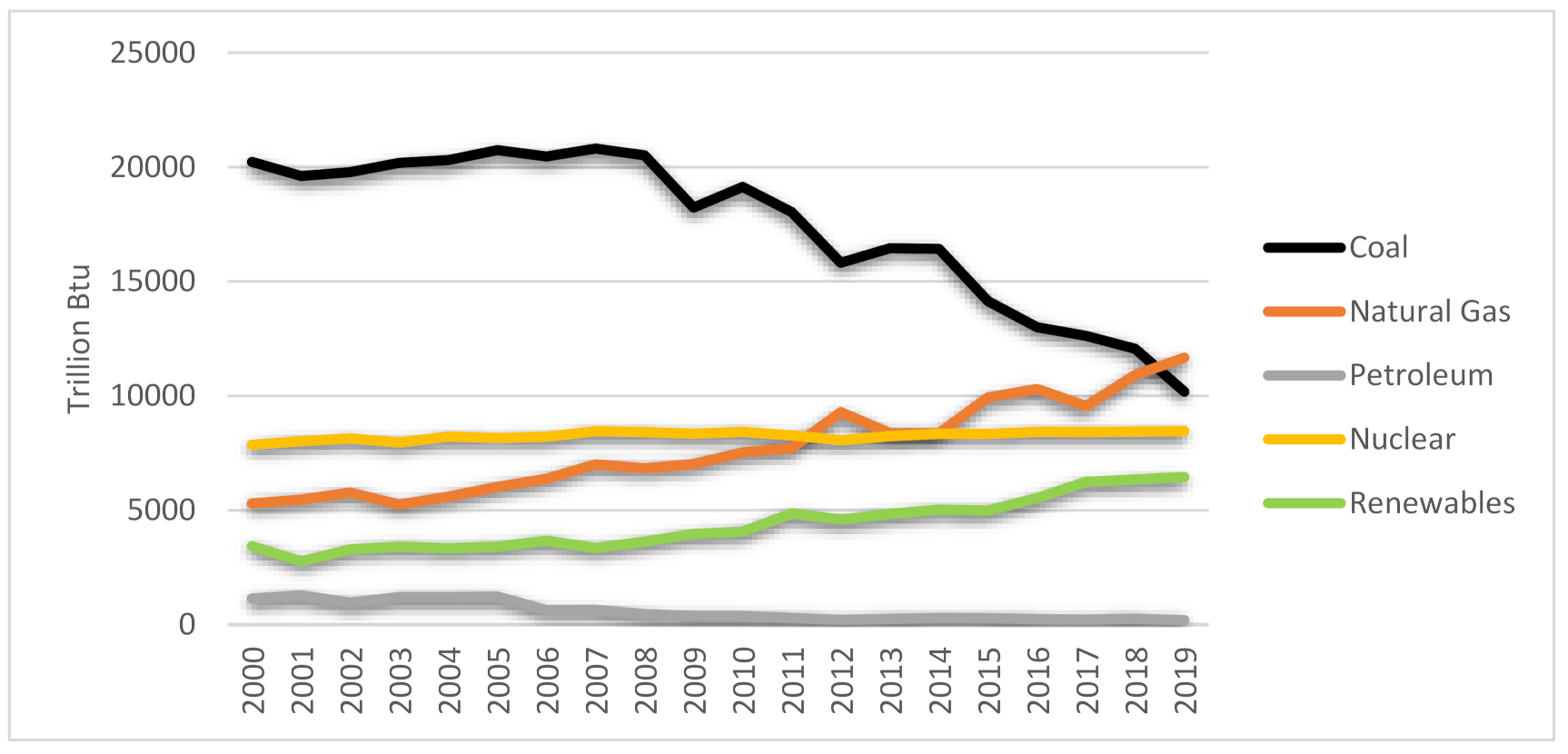


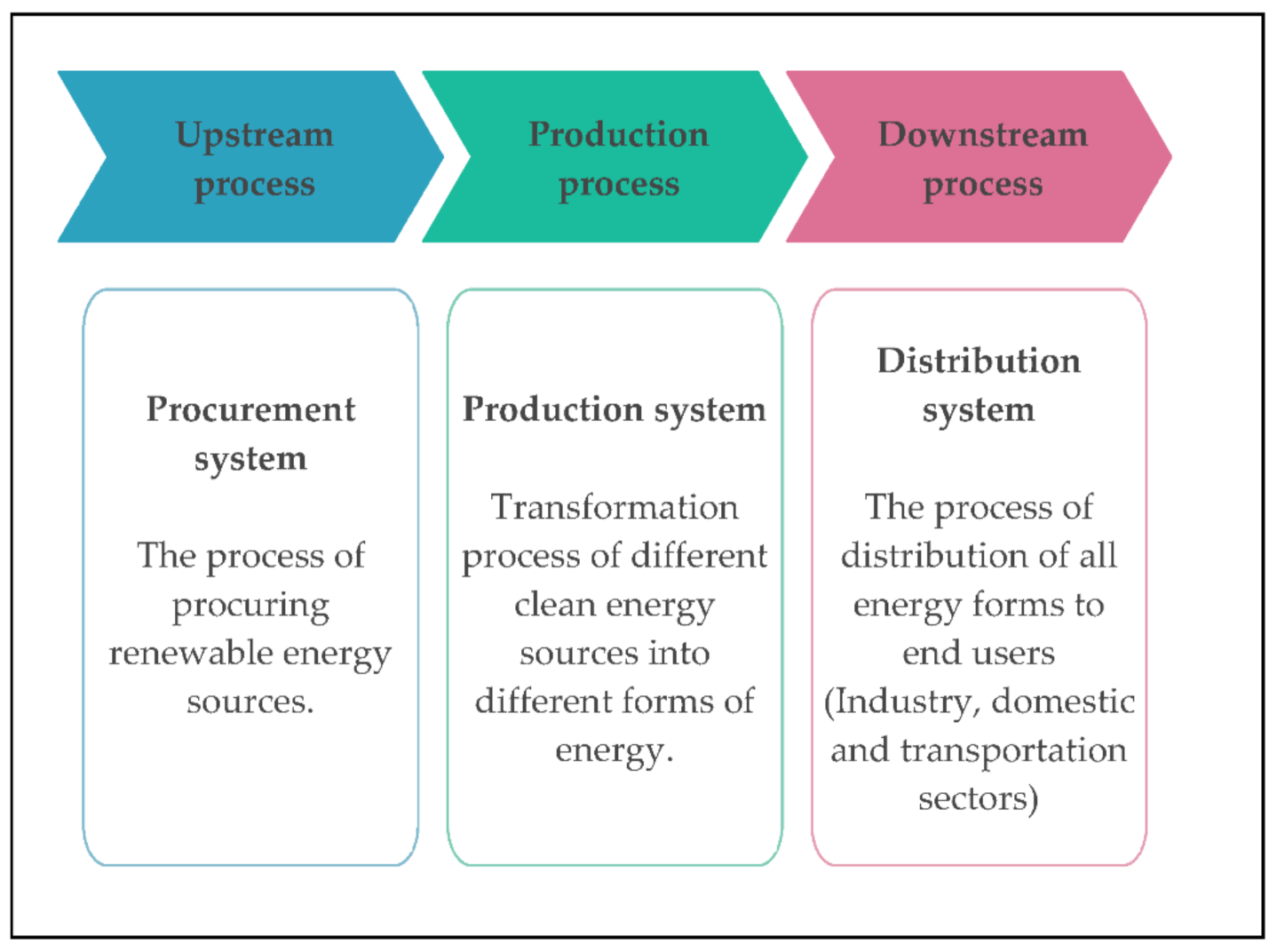

| Regions | Objectives of the Strategy on RE | Share of RE in Power Generation in 2018 | Targets for RE Share in Power Generation for 2030 |
|---|---|---|---|
| China | 29% [21] | 35% [22] | |
| United States | The proposed objectives for the strategy on RE in the United States [23]:
| 11% [8] | 25% [8] |
| Finland | 37% [26] | 51% [26] | |
| India | The key objectives outlined in the strategy to promote RE in India are as follows [27]:
| 10% [28] | 40% [28] |
| Morocco |
| 35% [32] | 52% [33] |
| Turkey | The main elements of Turkey’s energy strategy can be outlined as:
| 29% [35] | 38% [36] |
| Supply Chain Processes | Dimensions | Key Performance Indicator | How to Calculate | Unit |
|---|---|---|---|---|
| Upstream process of the supply chain | Economic dimension | Capital investment | The budget invested in renewable energy technologies used for electricity generation. | € |
| Transportation cost | The total cost of fuels from RE sources and especially biomass for electricity generation. | € | ||
| Procurement ROI | The measure of the financial profitability of acquiring RE sources. | % | ||
| Technical dimension | Supplier delivery performance | The ability of a supplier to deliver orders in full and on time. | % | |
| Environmental dimension | Combustible renewables (% of total energy) | The percentage of total energy from RE sources used to deliver the various resources and components related to RE technologies. | % | |
| Social dimension | Job creation rate | The percentage of people working in the procurement department for RE to generate electricity. | % | |
| Maturity of workforce | The percentage of people with valuable expertise in RE technologies, by region, in the procurement process. | % | ||
| Internal supply chain | Economic dimension | Operating and maintenance (O&M) cost | Total annual expenditure on RE technologies, e.g., operation and maintenance (O&M) costs. | € |
| Technical dimension | Efficient conversion rate | The ratio between input and output efficiency of equipment used for energy conversion. | % | |
| Energy losses | The sum of energy losses that occur when using the smart grid to meet the electricity demand. | kWh/year | ||
| Environmental dimension | CO2 emissions (carbon footprint) | The amount of CO2 released at production sites. | kg CO2/kWh | |
| Social dimension | Job creation rate | The percentage of people employed in the production department responsible for generating electricity from RE technologies. | % | |
| Maturity of workforce | The percentage of people with valuable expertise in RE technologies in the production process, depending on the region. | % | ||
| Downstream supply chain | Economic dimension | Cost of power delivery | Cost of delivering power to end-users | € |
| Technical dimension | Satisfaction rate | The percentage of the volume of energy delivered to end-users and the total volume of energy demand expressed by end-users. | % | |
| Environmental dimension | CO2 emissions (carbon footprint) | The amount of CO2 released during the activities of ensuring the availability of electricity to end-users. | kg CO2/kWh | |
| Fossil fuel consumption reduction | The percentage of decrease in the consumption of fossil fuels for electricity generation. | % | ||
| Social dimension | Access to electricity (% of the population) | The percentage of the population with access to electricity. | % |
Publisher’s Note: MDPI stays neutral with regard to jurisdictional claims in published maps and institutional affiliations. |
© 2021 by the authors. Licensee MDPI, Basel, Switzerland. This article is an open access article distributed under the terms and conditions of the Creative Commons Attribution (CC BY) license (http://creativecommons.org/licenses/by/4.0/).
Share and Cite
Jelti, F.; Allouhi, A.; Büker, M.S.; Saadani, R.; Jamil, A. Renewable Power Generation: A Supply Chain Perspective. Sustainability 2021, 13, 1271. https://doi.org/10.3390/su13031271
Jelti F, Allouhi A, Büker MS, Saadani R, Jamil A. Renewable Power Generation: A Supply Chain Perspective. Sustainability. 2021; 13(3):1271. https://doi.org/10.3390/su13031271
Chicago/Turabian StyleJelti, Faissal, Amine Allouhi, Mahmut Sami Büker, Rachid Saadani, and Abdelmajid Jamil. 2021. "Renewable Power Generation: A Supply Chain Perspective" Sustainability 13, no. 3: 1271. https://doi.org/10.3390/su13031271
APA StyleJelti, F., Allouhi, A., Büker, M. S., Saadani, R., & Jamil, A. (2021). Renewable Power Generation: A Supply Chain Perspective. Sustainability, 13(3), 1271. https://doi.org/10.3390/su13031271






